SS Ohio
 SS Ohio entering Grand Harbour in Malta lashed between two destroyers and a tugboat | |
| Career (USA, UK) | |
|---|---|
| Name: | Ohio |
| Owner: | Texas Oil Company, registered to the Eagle Oil and Shipping Co. Ltd. preceding Operation Pedestal. |
| Laid down: | 7 September 1939 |
| Launched: | 20 April 1940 |
| Acquired: |
Commissioned in the British Merchant Navy on 10 July 1942 |
| Decommissioned: | 15 August 1945 after irreparable damage. |
| Fate: | Sunk by being used for naval gunfire practice on 19 September 1946 |
| General characteristics | |
| Tonnage: | 9,264 GRT |
| Length: | 515 ft (157 m) |
| Speed: | 16 knots (30 km/h) (Sea trials 19 knots (35 km/h)) |
| Complement: | 77 men (24 to service the guns) |
| Armament: | 1 x 5-inch low-angle gun (aft) 1 x 3-inch AA-gun (bows) 1 x 40mm army Bofors abaft the funnel 6 x 20mm naval Oerlikons |
| Nickname(s): | "OH 10" |
The SS Ohio was an oil tanker built for the Texas Oil Company, (now Texaco). The ship was launched on 20 April 1940 at the Sun Shipbuilding Yard in Chester, Pennsylvania. She was requisitioned by the Allied forces to re-supply the island fortress of Malta, during the Second World War.[1]
The tanker played a fundamental role in Operation Pedestal, which was one of the fiercest and most heavily contested of the Malta Convoys, in August 1942.[2] Although Ohio reached Malta successfully, she was so badly damaged that she had to be effectively scuttled in order to offload her cargo, and never sailed again. The tanker is fondly remembered in Malta, where to this day she is considered to be the saviour of the beleaguered island.[3]
Construction and launch
Hull 190, as the Ohio was referred-to before her launch, was a skilful compromise, promising broad cargo-carrying capacity to the merchant and speed, balance and stability to the mariner. Above the waterline, the construction echoed the outward curve of a schooner's bow, bearing the influence of the old American clipper ship design. The design of Hull 190 was influenced also by the menace of a rearming Germany and a Japanese Empire bent on military expansion. The approach of war had influenced this design, the unofficial conversations between military and oil chiefs resulted in a ship of 9,264 gross register tons, 515 feet in overall length, and capable of carrying 170,000 barrels (27,000 m3) of fuel oil, bigger and with a larger capacity than any other tanker previously built. The ship was completed in the unusually short time of seven months and fifteen days.[4]
The Westinghouse turbine engines developed 9,000 driveshaft horsepower at ninety revolutions per minute, which allowed a maximum sixteen knots, a speed never attained before by any modern tanker of her era. Her method of construction was controversial. For some years, the issue of welding versus riveting had been raging on both sides of the Atlantic. Hull 190 was built using the new-fashioned welded method, hopefully proving once and for all its reliability.[4] The ship also had a composite framing system with two longitudinally continuous bulkheads, which divided the ship into twenty-one cargo tanks.
The ship was launched the day after that scheduled, prompting superstitious fear in the welders, steel-cutters and other craftsmen who had assembled to watch her launch. Hull 190 was christened in a ceremony presided over by the mother of the President of the Texas Oil Company, Mrs. Florence E. Rodgers who, grasping the ceremonial bottle of champagne in her hand pronounced the words:
I name this good ship Ohio. May God go with her and all who sail in her. Good luck…[4]
The ship slid down No. 2 slipway, entering the waters of the Delaware River. The existence of the Ohio would, in its initial years, be uneventful and ordinary, plying between Port Arthur and various other American harbours. She set a speed record from Bayonne to Port Arthur, covering 1,882 miles (3,029 km) in four days and twelve hours, an average of more than seventeen knots.[5]
Malta, "Pedestal" planning and the Ohio
In 1942, Britain was waging war in the Mediterranean against the German Afrika Korps and Italian forces in North Africa. Crucial[6] to this theatre of operations was the island of Malta,[7] sitting in the middle of Axis supply lines and, if supplied with sufficient munitions, aircraft and fuel, capable of causing severe shortages to the German and Italian armies in North Africa. Munitions and aircraft were available – during a brief lull in the Axis attacks, for example, the island's defenses were reinforced by thirty-eight Spitfire Mk V aircraft flown in from HMS Furious – but these, along with food and fuel, remained in critically short supply. Successive attempts at resupplying the island had mostly failed; the convoys "Harpoon" (from Gibraltar) and "Vigorous" (from Alexandria, Egypt), for example, saw most of their merchantmen sunk and escort ships damaged.[5] One of the ships lost during "Harpoon" was Ohio 's sister ship SS Kentucky, crippled by a German air attack and then sunk by Italian cruisers.[8]
On 18 June, following the failures of "Harpoon" and "Vigorous", the Commander in Chief of the Mediterranean Fleet cabled the British Prime Minister Winston Churchill to express his doubts about the possibility [the wisdom?] of attempting another convoy.[9] Three days later, the Ohio steamed into the mouth of the Clyde, under the command of Sverre Petersen, a former Master-in-Sail from Oslo, in Norway. In early May 1942, a radio message had reached Captain Petersen which diverted the ship to Galveston in Texas, and then ordered the tanker to proceed to Britain. Before leaving, the Ohio was fitted with one 5-inch (130 mm) gun on its stern, and a 3-inch (76 mm) AA-gun in the bows. She then moved to Sinclair Terminal, Houston in Texas, where the ship loaded a full cargo of 103,576 barrels (16,467.3 m3) of petrol (gasoline), finally sailing on 25 May. Ohio discharged her cargo at Bowling-on-the-Clyde, then steamed out into the tideway and anchored, awaiting orders.[5]
Here, the captain received a letter from Lord Leathers, the head of the British Ministry of War Transport, bidding the master a personal welcome and "...your safe arrival in the Clyde with the first cargo of oil carried in a United States tanker." However, the euphoria that such a message brought to the crew soon turned into resentment and anger. A telegram was received the same day by the head office of Texaco, from the War Shipping Administration, announcing simply that the Ohio was being requisitioned 'pursuant to the law '. The immediate reaction was a cabled message from Mr. T. E. Buchanan, General Manager of Texaco's Marine Department to the firm's London agent, that on no account was Ohio to leave her discharging port of Bowling-on-the-Clyde. A period of indecision, meetings and debates between the highest American authorities and their British counterparts soon ensued. The master was told that further orders would arrive soon afterwards. The decision was finally taken two weeks later, when a launch sped out to the ship anchored in the Clyde and Texaco's London agent, accompanied by an official of the British Ministry of War Shipping came over the side. They met the Captain, who was informed that the ship was to be confiscated and handed over to a British crew. The American crew and the captain were exasperated by the seemingly outrageous order, but had no other option but to give in, and started to pack their kit whilst British seamen began to take the ship over.[5]
On 10 July, Captain Petersen handed over the ship. There was no formal ceremony, and little goodwill. The American flag was taken down, and Ohio henceforward sailed under the "Red Duster". Overnight, she was transferred from American to British registry. For convenience in management, the tanker was handed over on 25 July to the Eagle Oil and Shipping Company, which was warned of the importance of the impending convoy and that "...much might depend on the quality and courage of the crew."[10]
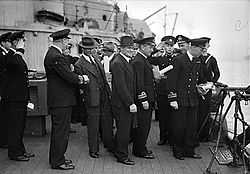
As the British crew started to assemble, it became clear that a large convoy was being planned. Command of the ship passed to Captain Dudley W. Mason, who at thirty-nine had already held other commands, while James Wyld was to be Chief Engineer. Forty-eight hours after Ohio had been transferred to British registry, her crew was completed. The ship's company numbered seventy-seven, including no fewer than twenty-four naval ratings and soldiers to serve the guns. The ship was then moved to King George V Dock in Glasgow, for the fitting of Oerlikon and Bofors anti-aircraft guns.
Ohio and "Pedestal"
Departure
After the disastrous failure of the mid-June convoys, it was wondered if Malta could hold out on the meagre supplies rescued from "Harpoon" and "Vigorous" until another convoy could be organised. Escorting merchant ships in the brilliance of a Mediterranean moonlit period was courting inevitable disaster. This situation limited operations in the immediate future to the moonless period in July or August between the 10th and 16th of those months. July passed as the Ohio could not be fitted-out in time. Once the due planning had been carried out it was decided to begin the operation in August. Ohio steamed down to Dunglass on the Clyde and loaded 11,500 tons of kerosene and diesel fuel oils. She was the only ship carrying these supplies which were so vital to Malta's survival. Before she sailed, however, special strengthening was given to the tanker to protect her against the shock of bombs exploding near her. In the previous convoy, the tanker Kentucky had been sunk with only a few hours' repair work needed on a steam-pipe, which had been broken by the force of such explosions. The Ministry was determined that this should not happen again, and so the Ohio's engines were mounted on rubber bearings, to reduce shock, and all steam-pipes were supported with steel springs and baulks of timber. While the merchant ships were gathering in the Clyde Estuary, the naval forces had already reached Scapa Flow. Admiral Syfret joined HMS Nelson there on 27 July and held a convoy conference on 2 August; the same day, all leave had been stopped. At eight o'clock that evening, two hours before dusk, the convoy sailed. The fourteen ships, led by HMS Nigeria formed up, it was dark by the time they reached the open sea.[11]
Axis attacks and damage
The convoy entered Gibraltar in heavy fog on 10 August. A day later, four torpedoes from the German submarine U-73 sank the aircraft-carrier HMS Eagle, killing 260 men, and losing all but four planes. On this day, German bombers attacked the convoy.[11] On 12 August twenty Junkers 88s attacked the convoy, while a further combined strike by 100 German and Italian Regia Aeronautica planes attacked the merchantmen. It was during the ensuing mayhem that the tanker was torpedoed by the Italian submarine Axum[12] and caught fire. The Ohio was hit amidships, where a huge pillar of flame leapt high into the air. Ohio seemed to be out of control. Captain Mason ordered the engines to be shut down, with all deckhands available fighting the fire with the deck water-lines. Lighted kerosene bubbled up from the fractured tanks, while little gouts of flame spattered the deck to a distance of thirty yards from the blaze. Fortunately, the flames were put out and the tanker managed thirteen knots after being repaired. The blast destroyed the ship's gyro and knocked the magnetic compass off its bearings, while the steering gear was put out of action, forcing the crew to steer with the emergency gear from aft.[13]
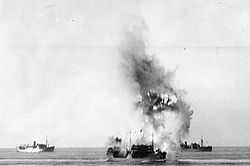
A hole, 24 feet by 27 feet, had been torn in the port side of the midships pump-room. The explosion had also blown another hole in the starboard side, flooding the compartment. There were jagged tears in the bulkheads and kerosene was spurting up from adjoining tanks, seeping in a film up through the holes in the hull. The deck had been broken open, so that one could look down into the ship. From beam to beam the deck was buckled, but the ship held together. Another sixty Stuka dive bombers attacked the convoy, focusing on Ohio.[10] A series of near misses ensued as the tanker approached the island of Pantelleria. Bombs threw spray over the decks of the tanker, while aircraft used their machine-guns. One near-miss buckled the ship's plates and the forward tank filled with water. The three-inch (76 mm) gun at the bows was twisted in its mountings and put out of action. A formation of five Junkers 88s was broken up by the tanker's anti-aircraft guns, with the bombs falling harmlessly into the sea. Another plane, this time a Junkers 87, was shot down by an Ohio gunner; however, the aircraft crashed into Ohio's starboard side, forward of the upper bridge, and exploded. Half a wing hit the upper work of the bridge and a rain of debris showered the tanker from stem to stern. The plane's bomb fortunately failed to detonate.[11] Captain Mason was telephoned from aft by the chief officer, who told Mason that the Junkers 87 had crashed into the sea and then bounced onto the ship. Mason 'rather curtly' replied: "Oh that's nothing. We've had a Junkers 88 on the foredeck for nearly half an hour."[14]
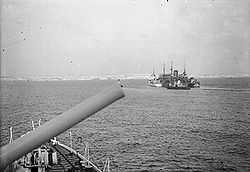
As the ship turned slowly to comb torpedoes, two sticks of bombs fell on either side of the tanker. The vessel lifted, and went on lifting until she was clean out of the water. Cascades of spray and bomb splinters lashed the deck, she fell back with a crash. The Ohio had differential gearing which slowed the propeller automatically; on other ships, the same effect would have shaken the engines out of their rooms. Continuously bombed, the tanker kept on steaming until another explosion to starboard sent her reeling to port. The engine-room lights went out, plunging it into darkness. The master switches had been thrown off by the force of the explosion, but they were quickly switched on again by an electrician. This time, the ship had not escaped damage. The boiler fires were blown out, and it was a race against time to restore them before the steam pressure dropped too low to work the fuel pumps. The engineers lit the fire starter torches to restart the furnaces.[15]
The complicated routine of restarting went forward smoothly and within twenty minutes the Ohio was steaming at sixteen knots again. Then another salvo of bombs hit the ship, shaking every plate, and once more the engines slowed and stopped. The electric fuel pumps had been broken by the concussion. While the crew desperately tried to reconnect the electrical wires and restart the engines via the auxiliary steam system, the engine-room was filled with black smoke until the engines were properly re-lit. The ship was making alternate black and white smoke and, with oil in the water pipes and a loss of vacuum in the condenser, the Ohio started to lose way slowly, coming to a stop at 10.50 am. The crew abandoned ship, boarding HMS Penn that had come to Ohio's aid alongside another destroyer, HMS Ledbury. The latter ship was soon to leave the stricken tanker after being ordered to go in search of the cruiser[16] HMS Manchester, which had been crippled by Italian motor torpedo boats.[17]
Under tow
Penn 's commanding officer, Commander J.H. Swain RN, offered Captain Mason a tow with a heavy ten-inch manila hemp rope. With the tow-line in place, Penn moved ahead, straining its engines to the limit; the Ohio continued to list to port. The two ships were not making any progress, even drifting backwards due to the easterly wind. Now both ships were sitting ducks, and as another serious attack developed, the destroyer went to full speed to part the tow. A German bomber dived on the tanker and was shot down by the Ohio 's gunners, but just before its demise, the aircraft's crew released their cargo.[18] A bomb hit the tanker just where the initial torpedo had hit her, effectively breaking her back, just as night was setting in. The ship was abandoned for the night. The day after, Penn was joined by the minesweeper HMS Rye. The two ships towed the tanker and succeeded in making up to five knots, overcoming the tendency to swing to port. However, another attack blasted the group of ships, snapping the tow lines and immobilizing the Ohio's rudder. Another bomb hit the fore-end of the front deck, forcing the engineers out of the engine room. Once more, Mason gave the order to abandon ship, as two more air attacks narrowly missed the tanker. A superficial examination showed that the rent that had developed in the amidships section had widened and that the ship had indeed almost certainly broken her back.[19]
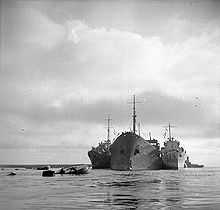
The two ships around the tanker were joined by HMS Bramham and by Ledbury, (the latter returning from her search for Manchester). Meanwhile Rye had again begun to tow Ohio with the newly arrived Ledbury acting as a stern tug. With less pull from Ledbury, a fair speed was maintained, but steering proved impossible. A stabilizing factor was needed, thus Commander Swain edged Penn to the starboard side of Ohio. Rye, joined by the Bramham, slowly got under way once more, with the Ledbury acting as a rudder. Another Axis air attack began just as the group of ships was moving at six knots. At 10.45 AM the first wave of dive-bombers came low over the water. Only one oil bomb landed close to Ohios bows, showering her with burning liquid. Then came three more echelons of German planes. This time, however, close air support from Malta was available.[20] Sixteen Spitfires, of 249 and 229 Squadrons from Malta, had sighted the enemy.[21] The first enemy formation wavered and broke. The second formation also broke, but one section of Junkers 88s succeeded in breaking free, making for the tanker. These were swiftly followed by the Spitfires. Three of the German planes were shot down or maneuvered to evade the Spitfires; nonetheless one bomber held its course, and a 1,000-pound bomb landed in the tanker's wake. The Ohio was flung forward, parting Ryes tow, buckling the stern plates of the tanker and forming a great hole.[22]
Arrival
Ohio was sinking not much more than forty-five miles west of Malta. Under the protection of the Spitfires, the danger of enemy attacks receded. After the tow line was parted, the Ledbury was still secured to the Ohio by a heavy wire which had been pulled round by the heavily yawing tanker, and had ended up alongside the Penn, facing the wrong way. After a quick analysis of the possibilities, it was decided to tow the tanker with a destroyer on either side of the tanker. Bramham was immediately ordered to make for port, while Penn remained coupled to the starboard side.[23] The speed was increased but kept to five knots, Ohio's deck was awash amidships. Now under the protection of the coastal batteries of Malta, the group of ships were slowly moving around the island, approaching Grand Harbour. The coastal batteries fired on a creeping U-Boat's conning tower, and scared off a group of E-Boats. Slowly, the group approached the tricky harbour entrance, near Zonqor Point. Here the group dispersed before a British-laid minefield.[24] At 6.00am, with Ohio still hovering on the edge of the minefield, the situation was eased by the arrival of the Malta tugs. With destroyers still linked on either side of the tanker, these sturdy ships made fast ahead and astern and the tanker was soon proceeding up the channel to the Grand Harbour entrance.[25] There, a fabulous welcome awaited them. On the ramparts above the wreck-strewn harbour, on the Barracca, St Angelo and Senglea, great crowds of Maltese men and women waved and cheered and a brass band on the end of the mole was giving a spirited rendition of Rule Britannia. Captain Mason, however, standing at the salute on the battered bridge of the Ohio, could spare not a moment's thought for the pride of bringing the ship to harbour, since the creaking plates showed that the Ohio might still go to the bottom of the Grand Harbour.[26]
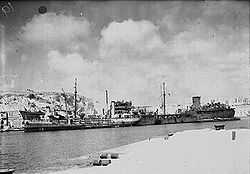
Pipes were now hauled aboard and emergency salvage pumps began to discharge the kerosene. At the same time, a fleet auxiliary, the Boxall, began to pump the 10,000 tons of fuel oil into her own tanks. As the oil flowed out, the Ohio sank lower and lower in the water. The last bit of oil left her and simultaneously her keel settled on the bottom.[27] Her captain, Dudley William Mason, was subsequently awarded the George Cross.[28]
Aftermath
After Ohio reached Malta, the ship broke in two from the damage she had sustained. There were insufficient shipyard facilities to repair the tanker, so the two halves were used for storage, and later barracks facilities for Yugoslavian troops.[29]
On September 19, 1946 the two halves of the Ohio were towed ten miles offshore and scuttled by gunfire from a destroyer.[30]
Epilogue
The final ship built for the Texaco fleet was the Star Ohio, in honour of the famous Second World War tanker. She is operated by Northern Marine Management on behalf of Chevron.
The nameplate, ships wheel, ensign and several other objects of the Ohio are preserved in Malta's National War Museum in Valletta.
See also
Notes
- ↑ Holland, James, Fortress Malta: An Island Under Siege, 1940–1943 (Cassell Military 2004) ISBN 0-304-36654-4.
- ↑ Spooner, Tony. Supreme Gallantry: Malta's Role in the Allied Victory, 1939–1945 (London, 1996).
- ↑ "Speech by HE Dr. George Hyzler, Acting President of Malta, on the Occasion of the 225th Anniversary of the American Independence". Retrieved 20 June 2007.
- ↑ 4.0 4.1 4.2 Shankland; Hunter (1983), Malta Convoy, Collins, ISBN 0-00-632964-0.
- ↑ 5.0 5.1 5.2 5.3 Pearson, Michael, THE OHIO AND MALTA, (Pen and Sword Books) ISBN 1-84415-031-3
- ↑ "The Second World War in the Mediterranean, North Africa and Italy". The We Were There Exhibition. Retrieved 20 June 2007.
- ↑ "War in the Mediterranean". The Royal Navy. Retrieved 20 June 2007. "The Mediterranean campaign revolved around the island of Malta, where the British based surface ships, submarines and aircraft [were] to attack the supplies for [the] Italian and German armies in North Africa. Major convoy operations were mounted to sustain Malta and the island narrowly survived."
- ↑ Moses, p. 73.
- ↑ Wade, Frank, A Midshipman's War: A Young Man in the Mediterranean Naval War, 1941–1943, Trafford Publishing (ISBN 1-4120-7069-4), Chapter IX.
- ↑ 10.0 10.1 Sam Moses, At All Costs: How a Crippled Ship and Two American Merchant Marines Turned the Tide of World War II, New York: Random House, 2006 (ISBN 0-345-47674-3).
- ↑ 11.0 11.1 11.2 "La Battaglia Di Mezzo Agosto" (in Italian). Retrieved 23 May 2007.
- ↑ Wingate, John. The Fighting Tenth: The Tenth Submarine Flotilla and the Siege of Malta (London, 1991).
- ↑ Thomas, David A, Malta Convoys (Pen and Sword Books) ISBN 0-85052-663-9.
- ↑ Arthur, Max - Forgotten Voices of The Second World War, 2004, Random House, ISBN 0091897343 p.172
- ↑ "Operation Pedestal and SS Ohio Save Malta". Retrieved 23 May 2007.
- ↑ "Royal Navy Cruisers Part 4". Archived from the original on 30 Jun 2012. Retrieved 25 May 2007.
- ↑ "Legion chief recalls horror sinkings". Retrieved 25 May 2007.
- ↑ "Merchant Marine Heroes". Retrieved 23 May 2007.
- ↑ Smith, Peter C., Pedestal: The Convoy That Saved Malta (Goodall Publications) ISBN 0-907579-19-1
- ↑ Smith, Peter C. The Battles of the Malta Striking Forces (London, 1974)
- ↑ McAulay, Lex. Against All Odds: RAAF Pilots in the Battle for Malta, 1942 (Milsons Point, Australia, 1989)
- ↑ Jellison, Charles A. Besieged: The World War II Ordeal of Malta, 1940–1942 (Hanover, NH, 1984)
- ↑ Bradford, Ernle. Siege: Malta 1940–1943 (New York, 1986)
- ↑ Leighton, Frank. Frayed Lifelines: A Siege Survivor's Story (Trafford Publishing) ISBN 1-55395-841-1
- ↑ Attard, Joseph. The Battle of Malta (London, 1980)
- ↑ Hogan, George. Malta: The Triumphant Years, 1940–1943 (London, 1978)
- ↑ Caroline Vernon. Our Name Wasn't Written – A Malta Memoir (Canberra, Australia, 1992)
- ↑ "George Cross Database Recipient: D.W. Mason". Retrieved 25 May 2007.
- ↑ "The Ohio". Archived from the original on 22 August 2006. Retrieved 23 May 2007.
- ↑ Operation Pedastal Geocities site (recovered)
References
- Smith, Peter C. (1974). The Battles of the Malta Striking Forces. London: Allan. ISBN 0-7110-0528-1.
- Hogan, George (1978). Malta: The Triumphant Years, 1940–1943. England: Hale. ISBN 0-7091-7115-3.
- Shankland and Hunter (1983). Malta Convoy. London: John Murray Publishers. ISBN 0-00-632964-0.
- Jellison, Charles A. (1985). Besieged: The World War II Ordeal of Malta, 1940–1942. USA: University of New Hampshire Press. ISBN 1-58465-237-3.
- Attard, Joseph (1988). The Battle of Malta. England: Progress Press Co. Ltd. ISBN 99909-3-014-7.
- McAulay, Lex (1989). Against All Odds: RAAF Pilots in the Battle for Malta, 1942. London: Hutchinson. ISBN 0-09-169570-8.
- Moses, Sam (2006). At all costs: how a crippled ship and two American merchant mariners turned the tide of World War II. Random House. ISBN 1-4000-6318-3.
- Vernon, Caroline (1990). Our Name Wasn't Written – A Malta Memoir. Australia: Imagecraft. ISBN 0-7316-7089-2.
- Wingate, John (1991). The Fighting Tenth: The Tenth Submarine Flotilla and Siege of Malta. London: Leo Cooper. ISBN 0-85052-891-7.
- Spooner, Tony (1996). Supreme Gallantry : Malta's Role in the Allied Victory, 1939–1945. London: Cassell Military. ISBN 0-7195-5706-2.
- Smith, Peter C. (1998). Pedestal: The Convoy That Saved Malta. England: Crecy Publishing Ltd. ISBN 0-947554-77-7.
- Thomas, David A. (2000). Malta Convoys. England: Pen and Sword Books. ISBN 0-85052-663-9.
- Bradford, Ernle (2003). Siege: Malta 1940–1943. England: Pen and Sword. ISBN 0-85052-930-1.
- Holland, James (2004). Fortress Malta: An Island Under Siege, 1940–1943. England: Cassell Military. ISBN 0-304-36654-4.
- Pearson, Michael (2004). The Ohio and Malta: The legendary tanker that refused to die. England: Pen and Sword Books. ISBN 1-84415-031-3.
- Wade, Frank (2006). A Midshipman's War: A Young Man in the Mediterranean Naval War, 1941–1943. England: Trafford Publishing. ISBN 1-4120-7069-4.
- Moses, Sam (2006). At All Costs: How a Crippled Ship and Two American Merchant Marines Turned the Tide of World War II. New York: Random House. ISBN 0-345-47674-3.
External links
| Wikimedia Commons has media related to SS Ohio. |
- Operation Pedestal and SS Ohio save Malta
- Timeline of events
- Detailed description of events
- Operation Pedestal: Saving Malta
- ADM 1/15526 catalogue entry for the official report on Ohio 's involvement in Operation Pedestal, held by The National Archives